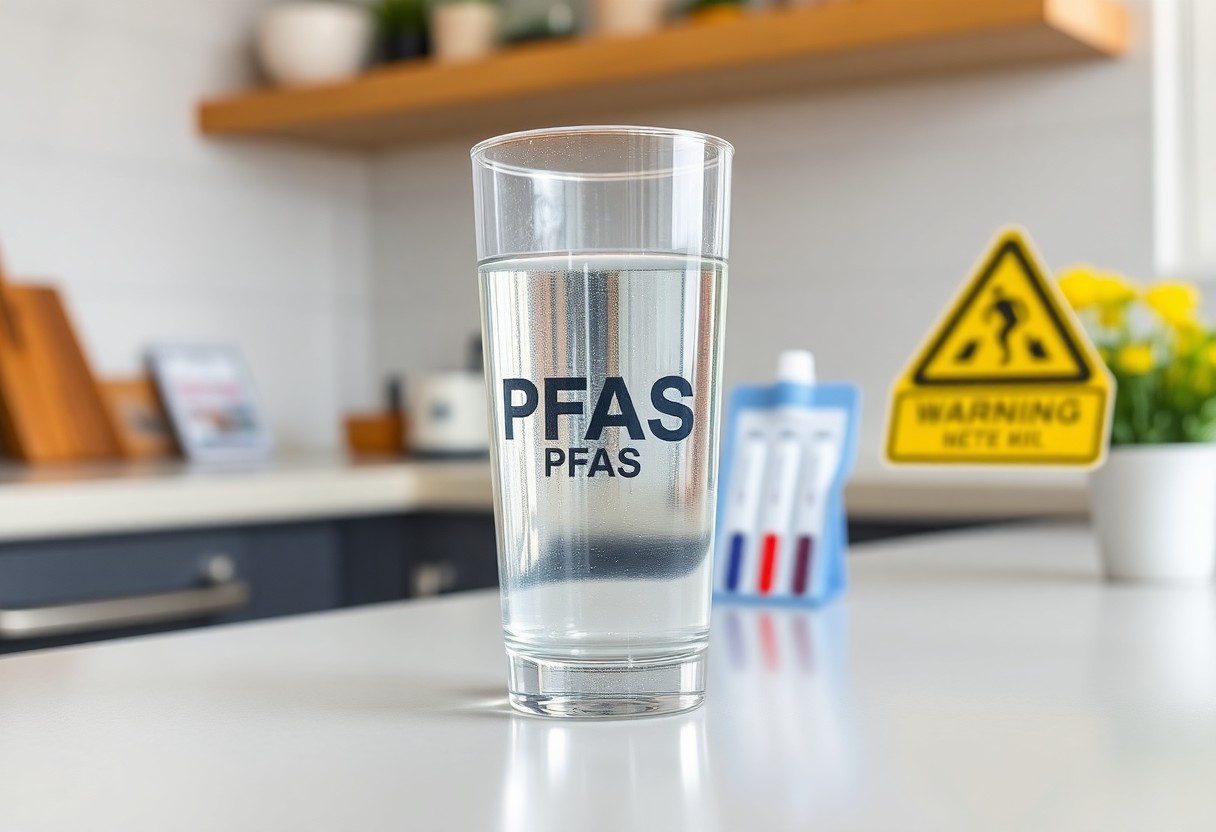You may have heard a lot of conflicting information about PFAS (per- and polyfluoroalkyl substances) in water, leading to confusion regarding their safety and health effects. Some myths portray these substances as harmless, while others exaggerate their risks. In this post, we will dissect the facts surrounding PFAS, helping you understand what these chemicals are, their potential dangers, and how they impact your health. By separating fact from fiction, you can make informed decisions for you and your family regarding water safety.

Understanding PFAS
The term PFAS refers to a large group of human-made chemicals known as per- and polyfluoroalkyl substances. These man-made compounds are commonly used for their water- and grease-resistant properties. PFAS are utilized in a variety of consumer products and industrial applications, making them prevalent in our environment.
Definition and Composition
To understand PFAS, you should know they are synthetic chemicals that consist of carbon-fluorine bonds, which are among the strongest in nature. This bond gives PFAS their resistance to breaking down in the environment and contributes to their persistence in water and soil.
Sources and Uses
Below are some common sources and uses of PFAS. You may encounter these chemicals in nonstick cookware, water-repellent clothing, stain-resistant fabrics, and food packaging materials. Their widespread application makes it challenging to avoid exposure.
A significant portion of PFAS contamination comes from industrial discharge, particularly from facilities that manufacture or use PFAS-containing products. Additionally, firefighting foams that contain PFAS are often used at airports and military bases, contributing to environmental pollution. While PFAS are known for their practicality, such as making items water-resistant, their persistence in the environment poses a serious risk to your health and the health of ecosystems, as they can accumulate over time and potentially lead to detrimental health effects.
Health Impacts of PFAS
You may be concerned about the potential health effects linked to PFAS exposure, commonly found in contaminated water. These substances are known for their persistence in the human body and the environment, raising alarms about their long-term health risks. Studies suggest that exposure to PFAS can be associated with adverse health outcomes, prompting increased awareness and advocacy for safer water practices.
Discussed Risks
Risks related to PFAS exposure include various health issues, such as liver damage, immune system disruption, and increased risks of certain cancers. You should be aware that even low levels of PFAS in drinking water might contribute to these adverse health effects, particularly among vulnerable populations, including children and pregnant women.
Scientific Findings
Above all, research highlights that PFAS chemicals can alter hormone levels and disrupt your metabolism. Various studies have linked these substances to increased cholesterol levels, liver dysfunction, and reproductive issues, emphasizing the potential for serious health complications. Regulatory agencies are beginning to classify some PFAS as likely human carcinogens, urging caution and further investigation.
Impacts of PFAS contamination have incited significant research efforts, revealing alarming patterns in health outcomes. The presence of PFAS in your drinking water is associated with immune system suppression, leading to a greater susceptibility to infections. Furthermore, the toxic effects on liver health and the correlation with certain types of cancer underscore the urgent need for remediation and stricter regulations. Awareness of these findings empowers you to advocate for cleaner water sources and make informed choices to protect your health.
PFAS in Water Regulation
Even as awareness about PFAS contamination grows, regulations surrounding these substances remain inconsistent across regions. Understanding the regulatory landscape is important for you to grasp how your access to clean water is being protected. Various agencies, such as the EPA, are developing strategies to address these contaminants, but the pace and effectiveness can vary, affecting your community differently.
Current Guidelines
With numerous studies linking PFAS to serious health risks, guidelines for acceptable levels of these chemicals in water are being regularly updated. Currently, the EPA recommends a health advisory level for certain PFAS, but these advisories are not legally enforceable. This ongoing evolution in guideline development highlights the importance of staying informed about the regulations that impact your water safety.
Government Actions
Behind the scenes, governmental agencies are taking steps to address PFAS contamination. Federal and state regulations are evolving to include stricter testing and reporting requirements. You may find that some local governments are going beyond federal guidelines to protect community health more effectively.
Even as these regulations are put in place, the challenge of regulating PFAS remains daunting. Many states have begun implementing their own standards, sometimes aiming for far lower levels than federal advisories. New legislation is being proposed to support research, improve monitoring, and mandate cleanup efforts in contaminated areas. This proactive approach reflects a growing recognition of the potential hazards PFAS pose to human health and the environment, emphasizing the need for swift action to safeguard your water supply.
Myths About PFAS
Now, it’s time to debunk some common myths surrounding PFAS in water. Many people believe that all PFAS are harmless or that they are only found in industrial areas. However, the truth is that these chemicals can be found in a variety of products and environments, affecting your water quality more than you might think. Understanding these myths is crucial for safeguarding your health and the health of your community.
Common Misconceptions
Myths about PFAS often lead to a misunderstanding of their potential dangers. For instance, some individuals may think that if they are not directly exposed to industrial sites, they are safe from PFAS. This misconception can leave you unaware of the presence of PFAS in consumer products such as non-stick cookware, water-resistant clothing, and even food packaging.
Addressing the Myths
Among the most pervasive myths is that PFAS are a recent concern. In reality, these chemicals have been in use since the 1940s and their impact on health and the environment is becoming increasingly recognized. Another common belief is that drinking or using water with low levels of PFAS is safe, when in fact, even low levels can accumulate over time and pose serious health risks.
Misconceptions about PFAS can lead to a false sense of security. It’s vital to understand that long-term exposure to PFAS has been linked to health issues like immune system dysfunction, hormonal disruptions, and even certain types of cancer. By educating yourself about the actual risks associated with PFAS, you can take proactive steps to mitigate your exposure, ensuring a healthier and safer environment for you and your loved ones.
Testing and Detection of PFAS in Water
After understanding the importance of PFAS testing, it is imperative to familiarize yourself with the methods available for detecting these harmful substances in water. Various advanced analytical techniques can identify and quantify PFAS levels, ensuring that you can assess potential risks to your health and the environment.
Methods of Testing
Beside laboratory analyses, there are also field testing kits available that allow for initial screenings of PFAS in water sources. Common laboratory methods include Liquid Chromatography-Tandem Mass Spectrometry (LC-MS/MS), which provides sensitive and accurate quantification of PFAS compounds, ensuring a thorough evaluation of your water sample.
Interpreting Results
Below is a key aspect of understanding your water’s PFAS levels, as the results can vary significantly. You must compare the detected concentrations against established safety standards to determine if your water is within acceptable limits or poses health risks.
Testing your water for PFAS will yield results that require careful examination. Understanding the concentration levels found in your sample is vital, as high levels of PFAS can pose serious health implications, such as hormonal disruptions and increased cancer risk. When you receive your results, compare them to EPA guidelines to gauge safety. Keep in mind that even trace amounts of certain PFAS can be concerning, so it’s imperative to seek further guidance if your results indicate a problem.
Ways to Reduce PFAS Exposure
Your awareness and proactive measures can significantly lower your risk of PFAS exposure. Start by using water filters that are effective at removing PFAS, and consider drinking bottled water if your local supply is contaminated. Additionally, limit the use of products containing PFAS—especially non-stick cookware, waterproof textiles, and personal care items. Always stay informed about your community’s water quality reports.
Personal Precautions
Against potential exposure, you can adopt simple lifestyle changes. Choose safer alternatives for household items and avoid fast-food packaging that may contain PFAS. Always wash your hands after handling products that could be contaminated, and keep children away from treated surfaces until you know they are safe.
Community Initiatives
Between advocating for local regulations and supporting education programs, community efforts play a vital role in minimizing PFAS contamination. Joining local environmental groups can help amplify your voice and raise awareness about PFAS concerns, pushing for stricter regulations on industries that release these harmful chemicals.
Indeed, community initiatives are important to combatting PFAS pollution. Collaborative clean-up events and advocacy for stricter regulations can lead to improved water safety and health outcomes. By engaging with local representatives, you can influence the adoption of policies that require testing and remediation efforts in your area. Furthermore, community education programs can empower residents to make informed choices about their consumption and bring attention to environmental justice issues related to PFAS exposure.
Final Words
Summing up, understanding the facts about PFAS in water is imperative for informed decision-making regarding your health and environment. You should be aware of the risks associated with exposure and the widespread misconceptions that may lead to confusion. By educating yourself on the science behind PFAS, you can advocate for cleaner water and engage effectively with community efforts aimed at addressing this pressing issue. Your awareness and actions can significantly contribute to improved public health and environmental safety.





















